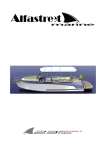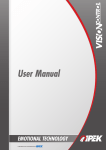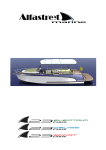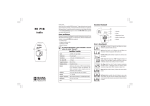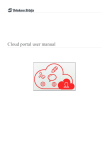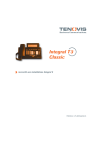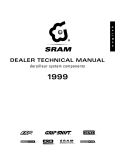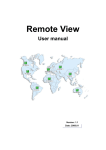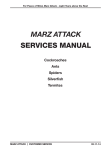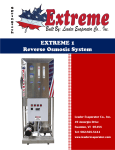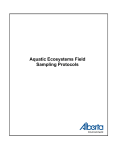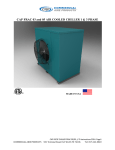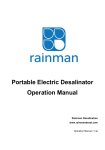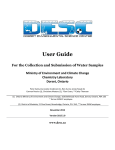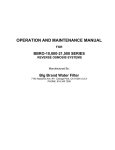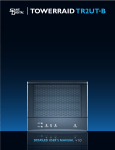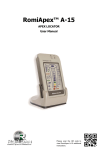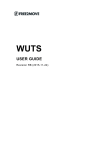Download MANUAL USE AND MAINTENANCE DEVICE FOR HOME USE FOR
Transcript
MANUAL USE AND MAINTENANCE DEVICE FOR HOME USE FOR THE TREATMENT OF DRINKING WATER WITH REVERSE OSMOSIS SYSTEM WAS V01 e WAS V02 Made in Slovenia TABLE OF CONTENTS GENERAL PART WATER TREATMENT FOR HUMAN CONSUMPTION CHARACTERISTICS OF FILTRATION SYSTEMS Pag. 3 Pag. 4 TECHNICAL DATA TREATMENT OF WATER WITH REVERSE OSMOSIS SYSTEM WAS TECHNICAL DATA WAS V01 TECHNICAL DATA WAS V02 HOW ARE MADE Pag. 7 Pag. 9 Pag. 11 Pag. 13 INSTALLATION PRE-INSTALLATION WARNING INSTALLATION THE WATER TESTS PROBLEMS AND SOLUTIONS Pag. 15 Pag. 17 Pag. 20 Pag. 24 MAINTENANCE SPARE PARTS INSTRUCTIONS FOR THE ORDINARY MAINTENANCE INSTUCTION FOR THE EXTRAORDINARY MAINTENANCE SANITIZATION Pag. 25 Pag. 27 Pag. 29 Pag. 32 DOCUMENTS WARANTY CERTIFICATES AND AWARDS DISPOSAL END USE WAS STATEMENTS OF INSTALLATION MAINTENANCE REGISTER Pag. 33 Pag. 34 Pag. 35 Pag. 36 Pag. 38 WHERE TO APPLY TECHNICAL ASSISTANCE CENTRE NOTES Pag. 39 Pag. 40 Nerviano, 2014-08-23 Manual use and maintenance WAS V01 – V02 Pag. 2 of 40 WATER TREATMENT FOR HUMAN CONSUMPTION IMPORTANT INTAKE OF HEALTHY AND PURE WATER IN THE HUMAN BODY Even today, many people are lagging health benefits caused by a problem too often ignored: the lack of pure water within your body. The man is made up of 70% water: it is therefore evident that all the cells, body tissues and the circulatory system need pure water to function correctly. QUALITY CONTROL The quality of the water supplied by aqueducts is ensured by a number of external controls as well as internal to the aqueducts themselves the responsibility of local health services (ASL). The parameters to be analyzed and the limit values are established by the law. For non-harmful substances and various other water features parameter “indicators” exist. If these are not respected, the law requires that the local health authorities valuate whether it is appropriate to have “measures to restore water quality.” It is important to note that the aqueduct is held responsible for the quality of the water up to our house but not to the tap. Which means that the internal piping of the houses and the presence of tanks with autoclave could change the water quality, in particular regarding the presence of certain metals. AND WHEN THE LIMITS ARE EXCEEDED OR WHEN WE NEED WATER EVEN MORE PURE? We must have a device for water treatment. Nerviano, 2014-08-23 Manual use and maintenance WAS V01 – V02 Pag. 3 of 40 CHARACTERISTICS OF FILTRATION SYSTEMS In filters of reverse osmosis water is forcibly conducted, arising its pressure, through a spillproof membrane thoughout which only certain substances in certain quantities can pass. It is the most efficient filtration system, acts on heavy metals, nitrates and other undesirable substances, it also acts on the water hardness. Nerviano, 2014-08-23 Manual use and maintenance WAS V01 – V02 Pag. 4 of 40 THE REVERSE OSMOSIS The principle of osmosis is known from the early years of the last century, it is the principle that the mineral salts liquid retention winning atmospheric pressure, even through obstacles that may provide resistance, such as semi-permeable materials. This principle allows the cells of our body to eat properly, in fact, they are covered with a semipermeable membrane, which allows you to filter the food and minerals they need and excrete substances not used. In nature, osmosis occurs, when two solutions of varying salt concentration, are separated by a semipermeable membrane: the solution with a lower concentration of salt passes through the membrane and goes to dilute the solution with increased salt concentration (Figure A). By reversing this process, you get the reverse osmosis: pushing pressure with a saline solution against a semipermeable membrane, separation is obtained of the pure water from the impurities that are not able to pass through the micropores of the membrane (figure B). The reverse osmosis principle, therefore, is to force the water through a semipermeable membrane, in order to separate the substances of organic and inorganic origin dissolved in it. While having micropores, the reverse osmosis membrane should not be considered as a common filter. The traditional filter has a filtration degree of the lowest and therefore does not allow the arrest of inorganic substances and is designed to retain the impurities within it. The reverse osmosis membrane, however, besides having a higher degree of filtration, is constructed in such manner that the bacterial substances that do not pass through it is expelled. Nerviano, 2014-08-23 Manual use and maintenance WAS V01 – V02 Pag. 5 of 40 SOME TIPS FOR CHOOSING THE RIGHT REVERSE OSMOSIS FILTRATION SYSTEMS The reverse osmosis devices must observe the following conditions: a) the operation must be fully automatic b) there must be a device capable of ensuring the non returning of the water to the exhaust; c) membranes and other components of the system in contact with the water must meet the requirements prescribed for materials intended to come into contact with food and beverage; d) if a collection tank of the downstream treatment is provided, the plant must be equipped with a system for continuous disinfection, preferably chlorine or its compounds, or by the use of ray lamps U.V.; e) when the arrangements for continuous disinfection are different from those above-report, such rules must be approved by the Ministry of Health on the basis of compliance with the experimental protocol. f) in the pretreatment of the waters covered by the process of reverse osmosis activated carbon filters and microfilters are allowed; g) substances used in retreatment must meet the standards requirements of purity required for usage in the food or drinking water treatment. Nerviano, 2014-08-23 Manual use and maintenance WAS V01 – V02 Pag. 6 of 40 TREATMENT OF WATER WITH REVERSE OSMOSIS SYSTEM WAS IN WHAT WAY IS IT DIFFERENT FROM OTHER REVERSE OSMOSIS DEVICES? • WAS reverse osmosis devices are a Slovenian product • The materials used are of the highest quality • Are compact and of modern design • Electronic program for operation and quality of water control • Direct filtering system without collection tanks thanks to high performance pump • Automatic wash system in case of not using the water purifier prevents the formation of bacteria • Equipped with water-stop system that blocks any loss • Sound and light signals to alert in case of malfunction • Signals indicating the need for filters replacement • Reliable operation • Simple maintenance thanks to quick couplings MORE ABOUT THE V02 VERSION • Water temperature can be regulated (+8°C) Nerviano, 2014-08-23 Manual use and maintenance WAS V01 – V02 Pag. 7 of 40 DIMENSIONS FILTER WITH WAS Inlet water is filtered by means of: • pre-filter ( sand, mud, sediments ) • activated carbon filter ( chlorine, poisons that bind with activated carbon ) • double osmosis filters ( heavy metals, pesticides, nitrates, asbestos, bacteria, viruses.. ) Water is filtered when needed. The high pressure pump of the device provides 1,2 l/minute purified water just with the simple press of the button. Reverse osmosis filters rinse themselves. We get 0,6 l of purified water out of 1 l tap water through the special tap included in the installation kit. The rest of the water goes down the drain along with the impurities. The osmosis filter life is 4 to a maximum 7 years with normal use and regular maintenance. Device electronic parts provide sound and light signals for: • the quality of water we use, • use of filters, • lack of water, • water leak – Water Stop - the water flow stops. Nerviano, 2014-08-23 Manual use and maintenance WAS V01 – V02 Pag. 8 of 40 TECHNICAL DATA WAS V01 WAS V01 is an appliance for domestic use for the treatment of drinking water. It is based on the reverse osmosis principle , the principle through which uses a semipermeable membrane in order to reduce the salt content of the water. WAS V01 is thus presented as the ideal to improve the organoleptic characteristics of the drinking water supplied by the public service . It is able to produce water of high quality for various uses , not only for drinking but also for washing vegetables and for cooking. WAS V01 consists of a box and a lid galvanized epoxy powder coated steel. The front panel is made of plastic with LED light bar to display the permeate conductivity and durability of filters, two lights for the reporting of various alarms purifier and an inside button (can be operated with a small nail ) for displaying the LED bar. The rear panel has externally in the power supply with built-in fuse holder and two fittings for the permeate outlet and discharge, the adjustment screw by-pass and the nipple of the solenoid water inlet . First , there is a main switch for the light switching on and off. Inside are housed : - Solenoid valve inlet water supply. - Pre-sediment filter - Activated carbon filter - Two osmosis membranes Filmtec ( contained in two vessel ) - By-pass valve mixing water - A minimum pressure n.a. for the protection of the feed pump . - A 180-watt electric motor - A rotary vane pump - An electronic card for operation. - A probe for the measurement of the conductivity. - Sensor reporting any loss of water (Water Stop). All materials in contact with water (pipe fittings , pipes , containers, etc.), are constructed in material for food use. Nerviano, 2014-08-23 Manual use and maintenance WAS V01 – V02 Pag. 9 of 40 DIMENSIONS FEATURES WAS V01 is compact , controlled by the computer , positioned below the sink . - Output capacity is up to 1,700 liters (456 gallons ) of filtered water a day - No tank, direct flow - Display of conductivity measurements and filter consumption LED - Buzzer for alarm - Power supply voltage 220V, 50Hz - Power consumption: 3A – 300W REQUIREMENTS FOR THE SMOOTH FUNCTIONING - Pressure of water supply: from 1 to 4 bar - Scope of supply: minimum 120 l / h - Working pressure: max 10 bar downstream of the pump - Working Range: up to 100 l/h - Ambient temperature: +5 ° C to +35 ° C - Water temperature: from +5 ° C to +35 ° C - Relative humidity: 95% non-condensing environment WARRANTY - Certified by Institute of Public Health - CE certified - 24 month warranty Nerviano, 2014-08-23 Manual use and maintenance WAS V01 – V02 Pag. 10 of 40 TECHNICAL DATA WAS V02 WAS V02 is an appliance for domestic use for the treatment of drinking water. It is based on the reverse osmosis principle , the principle through which uses a semipermeable membrane in order to reduce the salt content of the water. WAS V02 is thus presented as the ideal to improve the organoleptic characteristics of the drinking water supplied by the public service . It is able to produce water of high quality for various uses , not only for drinking but also for washing vegetables and for cooking. WAS V02 consists of a box and a lid galvanized epoxy powder coated steel. The front panel is made of plastic with LED light bar to display the permeate conductivity and durability of filters, two lights for the reporting of various alarms purifier and an inside button (can be operated with a small nail ) for displaying the LED bar. The rear panel has ela externally in the power supply with built-in fuse holder and two fittings for the permeate outlet and discharge, the adjustment screw by-pass and the nipple of the solenoid water inlet . First , there is a main switch for the light switching on and off, Inside are housed : - Solenoid valve inlet water supply - Pre-sediment filter - Activated carbon filter - Two osmosis membranes Filmtec ( contained in two vessel ) - By-pass valve mixing water - A minimum pressure n.a. for the protection of the feed pump - A 180-watt electric motor - A rotary vane pump - An electronic card for operation. - A probe for the measurement of the conductivity. - Sensor reporting any loss of water (Water Stop). All materials in contact with water (pipe fittings , pipes , containers, etc.), are constructed in material for food use. Nerviano, 2014-08-23 Manual use and maintenance WAS V01 – V02 Pag. 11 of 40 DIMENSIONS FEATURES WAS V02 is compact , controlled by the computer , positioned below the sink . - Output capacity is up to 1,700 liters (456 gallons ) of filtered water a day - No tank, direct flow - Display of conductivity measurements and filter consumption LED - Buzzer for alarm - Power supply voltage 220V, 50Hz - Power consumption: 3A – 300W REQUIREMENTS FOR THE SMOOTH FUNCTIONING - Pressure of water supply: from 1 to 4 bar - Scope of supply: minimum 120 l / h - Working pressure: max 10 bar downstream of the pump - Working Range: up to 100 l / h - Ambient temperature: +5 ° C to +35 ° C - Water temperature: from +5 ° C to +35 ° C - Relative humidity: 95% non-condensing environment WARRANTY - Certified by Institute of Public Health - CE certified - 24 month warranty THE ABOUT CHARACTERISTICS ARE IDENTICAL TO VERSION V01 MORE OVER THE VERSIONE V02 HAVE: The water cooling system Nerviano, 2014-08-23 Manual use and maintenance WAS V01 – V02 Pag. 12 of 40 HOW ARE MADE PANEL CONTROL LED light control for status signalisation WITH HIGH PERFORMANCE PUMP THE COLLECTION TANK IS NOT NECESSARY BEFORE DOWNSTREAM PROCESSING The WAS devicess are without collection tank and this allows an increase of the flow of purified water thus ensuring a constant and elevate flow, in fact, while in systems with tank the flow is generated by the pressure in the tank itself, in the WAS devices the flow is generated by a pump with high performance. Also, the stagnant water contained in the tank can sometimes accumulate germs, bacteria, etc. for this reason, the systems with the collection tank must necessary have the UV lamp. The WAS devices being direct production plants have many advantages including: - Absolute bacteriological purity - No the water heating due the U.V. lamp because it is not necessary, - Do not need replace the U.V. lamp every year, with savings on maintenance costs. Nerviano, 2014-08-23 Manual use and maintenance WAS V01 – V02 Pag. 13 of 40 NOTE The WAS V01 as well as the WAS V02 are supplied with pre-filter inside the chassis (see figure left), you can still order without pre-filter in which case the interior will look like in the figure on the left. LESS WASTE WATER The reverse osmosis devices of old conception produce a considerable amount of waste water as resulting of there osmosis process. The WAS devices are made so as to minimize the amount of waste water. SELF-CLEANING SYSTEM OSMOTIC MEMBRANE A characteristic of the WAS devices consists in washing the osmotic membrane through a flow of water at high pressure. During the filtration the water passes into the osmotic membrane which retains all the impurities, when the amount of salts and waste substances exceeds the allowed level, the membrane no longer has the same purifying capacity that had initially. in this case the automatically cleaning system intervenes, the substances trapped in the osmotic membrane are so discharged thus restoring its efficiency. COMPUTER CONTROL The WAS devices are equipped with computers capable of controlling the entire process of filtration. Computer control of water quality, pressure control, water consumption counting, etc. Nerviano, 2014-08-23 Manual use and maintenance WAS V01 – V02 Pag. 14 of 40 PRE-INSTALLATION WARNING Installation devices for home use for treatment of drinking water with reverse osmosis system WAS - Simply press the button of the tap supplied in the installation kit to use the device, - Installation takes on average an hour, - You can install your device under the kitchen sink., - The device is constructed in such a way, that it is easier to carry out reset (just CLICK), - Sound and light signals inform us of any abnormalities. WAS V01 and V02 are easy to use and most importantly it is completely automatic. Once installed and calibrated, simply turn on the main power switch and press the button on the faucet, let the water run for a few seconds before you remove it. Once you have taken the amount of water needed, press the button on the faucet to stop dispensing. INSTALLATION KIT The supply includes what is necessary for the first installation , piping, drain hose fitting water tap , power cord electric current. Of course the kit with installation, above , is scheduled for installation in standard and that is to have close to about 1.5 m an electrical outlet and that there is a water shut off valve with 3/ 4 ” typical attack for dishwasher / washing machines. RECOMMENDATIONS - The manual has been prepared to provide you , as clearly as possible all the information required for installation , use and maintenance of the WAS device. – Before using the appliance read , in all its parts , the user manual and maintenance , knowledge of the information and instructions contained in this manual , are essential for the proper installation and proper use of the device by the user. – WAS has been designed and built with mechanical and electrical safety measures to protect you from physical , is the responsibility of the purchaser to ensure that all users are aware of the information and recommendations in this manual . - Only original spare parts is guaranteed by the functional reliability and performance optimization of the device; applying changes , supplies or devices of any kind to the equipment, unless specifically provided for in the manual, are to be considered total responsibility of the user. Nerviano, 2014-08-23 Manual use and maintenance WAS V01 – V02 Pag. 15 of 40 WARNINGS - Make sure that the hot water cannot enter into the device (28°C max); – Make sure that the heater is not used with water under 5°C or in areas subject to frost; – The water supply pressure must be between the maximum of 0.4 MPa (4 bar) and the minimum of 0.1 MPa (1 bar) . For pressures above 0.4 MPa or in case of water hammer , it is essential a pressure regulator ; – Never operate the unit in the absence of water, what could destroy the pump ; – In case of continuous operation can take place on the electric heat that will stop the engine from overheating until you will not be cooled again ; – For a perfect preservation membranes are kept in a liquid bacteriostatic , do not use so the first water produced from a new plant or where it replaced the osmotic membrane , but let it slide for about 30 minutes ; – Leave a liter anyway scroll after each stop ( over 24 h ), and is of higher quality than that remained in osmotic membrane; – For long periods so it is advisable to sanitize the system and slide for at least 10 – 15 minutes the water. GENERAL INFORMATION - Always remove the power cord from the outlet before carrying out any maintenance work or cleaning equipment. – Before connecting the power cord to the power outlet , ensure that the mains voltage is the same as that stated on the label . Voltage dips , higher or lower than 10% of the nominal value , can damage the electrical parts of the equipment. – This appliance must be used only for what it was designed, ie for the treatment of water for drinking purposes from the public water supply. – To clean the device does not use corrosive products , acids, steel wool or steel brushes. – Do not wash the machine with direct water jets. – The manufacturer disclaims any liability whatsoever for any damage to persons or things caused by non-observance of the instruction provided in the manual. Nerviano, 2014-08-23 Manual use and maintenance WAS V01 – V02 Pag. 16 of 40 INSTALLATION BEFORE INSTALLATION POSITIONING - Before proceeding with the installation, check that there is enough space. (eg. at least 500mm deep) CONTROL FILTERS - Rinse well, the activated carbon filter before installing it. - The reverse osmosis membranes contain a preserving agent for the storage and transportation. Clean the membrane by this agent before using the water produced. INSTALLATION FAUCET - Check before you make the hole in the floor on the underside of the sink if there is scope for tightening and connections to the faucet with the supplied accessories. - Warning in case of semi-precious stones (eg. granite) turn to specialized companies. - In case of use of a three-way mixer follow the directions of the manufacturer of the faucet. ELECTRICAL CONNECTION - Verify that there is a socket 220 V – 50 Hz in the immediate vicinity of the device, where to insert the power plug, it has a grounded and connected to a life saving device. Nerviano, 2014-08-23 Manual use and maintenance WAS V01 – V02 Pag. 17 of 40 HYDRAULIC CONNECTION - WATER INLET - Blue pipe with junction 3/4″ to be connected to the water shut off valve. - PURIFIED WATER OUTLET - Blue pipe Ø 6 - DRAIN - Red pipe Ø 6 INSTALLATION PROCEDURE - Install a shut-off valve ¾ ” (faucet for washing machine ) for power , where it will be installed at the device. Make sure that the feed device is coming from the public water supply. - Drill holes in the floor where it will be installed on the faucet . - Attach the faucet to the plan. - Remove the screws and the cover of the device. - Tighten the two ends of the feeding tube blue , supplied , the correct fitting of the shut-off valve and solenoid valve. - Connect the blue hose Ø 6 , supplied , to the tap and the outlet connector of the permeate through the proper fittings . - Perform a 6 mm hole on the exhaust pipe of the sink , slide on the exhaust pipe of the plant the ” tie ” and tighten not too sure that the tube and the hole coincide. Connect the intake hose Ø 6 red, supplied through the proper fittings . Nerviano, 2014-08-23 Manual use and maintenance WAS V01 – V02 Pag. 18 of 40 OPERATION 7.1 Connect all the pipe , pushing it deeply tubes red and blue on the quick couplings ( red and blue on the drain fitting on the fitting of the permeate ) and tighten the fittings ¾ ” on the solenoid valve and the shut-off valve. 7.2 Check any water leaks 7.3 Connect the water power cord a the device. 7.4 Slowly open the valve on the water. WARNING DO NOT OPERATE THE DEVICE BEFORE YOU OPEN THE FAUCET WATER INLET 7.5 Connect the power cord into the wall outlet , turn on the power switch on the device and crush the switch on the faucet . 7.6 Allow water to run for 15 minutes and check that there are no water leaks inside and outside of the equipment. 7.7 Take from the faucet a water sample and perform the measurements. see the water test 7.8 Intervening with a screwdriver on the by-pass valve on the back of the system and make appropriate adjustments : Turn counterclockwise to increase the percentage of untreated water to be mixed to permeate, turning clockwise to decrease this percentage . For each adjustment repeat the measurements . 7.9 After reaching the desired mix , put the lid on the water purifier and tighten the screws. ADJUSTMENTS I WAS devices are equipped with by-pass valve ( section 7.8 ) for adjusting the residual salinity and hardness as required by Ministerial Decree 443 of December 1990. The measurement must be performed with a specific conductivity , various measures must be taken by discarding the overhead product, ( see section tests). WAS is now ready for use. Nerviano, 2014-08-23 Manual use and maintenance WAS V01 – V02 Pag. 19 of 40 THE WATER TESTS ADJUSTMENTS The devices are equipped with WAS valve bypass ( section 7.8 ) for adjusting the residual salinity and hardness as required by Ministerial Decree 443 of December 1990. The measurement must be performed with a specific conductivity , various measures must be taken by discarding the overhead product . SOME BASIC CONCEPTS pH What it is: The pH indicates the acidity or alkalinity of the water. E ‘ measured on a scale of values between 0 and 14 units. Limit Law ( Legislative Decree 31/2001 ): Between 6.5 and 9.5 units. What means: The pH is a basic parameter that indicates whether the water is polluted with acids or strong bases. Nerviano, 2014-08-23 Manual use and maintenance WAS V01 – V02 Pag. 20 of 40 HARDNESS What it is: This indicates the abundance of calcium ions (Ca2 + ) and magnesium ( Mg 2 + ) in the water. Limit Law ( Legislative Decree 31/2001 ) : Between 15 and 50 ° F ( French degrees ) . What indicates : The hardness is a parameter that expresses the total content of certain salts in the water , mainly calcium carbonate (CaCO3 ) and magnesium carbonate ( MgCO3 ) . The unit of measure is the degree of hardness French ( ° F) which is equivalent to 10 milligrams of calcium carbonate per liter of water. Unless there are medical indications details, the water which has values in the range recommended by the Legislative Decree 31/2001 are suitable for human consumption. ELECTRICAL CONDUCTIVITY What is: The electrical conductivity is a parameter that indicates the content of dissolved salts in the water. There is talk of electric conductivity because the salts in water are as charged ions and as such allow the passage of current in the water itself . Limit Law ( Legislative Decree 31/2001 ): The electrical conductivity of the water should not exceed 2500 mS / cm at 20 ° C. What indicates : The electrical conductivity of the water increases proportionally to the amount of dissolved salts in water: the greater the quantity of salts dissolved in it, the higher is also the electrical conductivity of water. It is generally advisable not to exceed the values laid down by law or by the fitness for human consumption and to ensure a good taste of the water. What to do in case of out parameter: Each water has values of electrical conductivity characteristic , related to the salts dissolved in it. If you want to reduce the conductivity of the water (the amount of dissolved salts ) you can use methods of treatment based on reverse osmosis. FIXED RESIDUAL What is: It expresses the degree of mineralization of the water, ie the quantity of solid substance which remains perfectly dried by evaporating a known amount of water. Limit Law (Legislative Decree 31/2001): The maximum expected value for water intended for human consumption is equal to 1500 mg / l. What indicates: Generally, this parameter is used to classify the level of mineralization of the water; based on its value differ slightly mineralized water (up to 50 mg / l), trace elements (up to 500 mg / l), average mineralized (between 500 and 1500 mg / l) and high salt (over 1500 mg / l). What to do in case of out parameter: The residue of water is related to its origin and rocks along which it passes to reach the aquifer. A high value of fixed residue is almost never due to contamination of a chemical nature, but has a Nerviano, 2014-08-23 Manual use and maintenance WAS V01 – V02 Pag. 21 of 40 natural origin. If you want to reduce the values of fixed residue could use filtration systems or methods of treatment based on reverse osmosis. FOR MORE INFORMATION We invite you to visit the company website of HANNA INSTRUMENTS – HANNACHECKER – CONTROLLO ACQUA POTABILE Nerviano, 2014-08-23 Manual use and maintenance WAS V01 – V02 Pag. 22 of 40 EQUIPMENT WITH WHICH WE CAN PERFORM THE FIELD MEASUREMENTS BEFORE AND AFTER THE INSTALLATION CONDUCTIVITY AND WATER HARDNESS Using the conductivity meters or dissolved solids (TDS) is possible to obtain an excellent approximation of the value of water hardness, even in French degrees. The hardness is determined by the concentration of calcium carbonate (CaCO3) and magnesium carbonate (MgCO3), which constitute about 90% of the dissolved solids in the water. The unit of measurement of the hardness is the most common grade French (° f), defined as 1 f = 10 ppm CaCO3 So dividend for 10 measurements in ppm, obtained with a gauge of dissolved solids (TDS), you get the water hardness value with an error of 2-3 ° f. 1 ppm = 2 mS / cm whereby 1 f = 20 mS / cm Dividing by 20 the measures in mS/cm once you get the water hardness value with an error of 2-3 ° f. THE INSTRUMENTS You can find the right tools in order by visiting the company’s production HANNA INSTRUMENT FOR MORE THOROUGH ANALYSIS REQUIRES CONTACT WITH THE LABORATORY ANALYSIS OF WATER. Nerviano, 2014-08-23 Manual use and maintenance WAS V01 – V02 Pag. 23 of 40 PROBLEMS AND SOLUTIONS REDUCTION WATER FRON THE TAP Faulty pump Replace the pump Clogged filters Replace carbon filter and prefilter Osmosis membrane clogged Clean or replace the osmosis membrane Solenoid valve partially Clean or replace the solenoid blocked valve NO WATER FRON THE TAP Sediment filter clogged Change filter sediments Osmosis membrane clogged Change osmosis membrane ALARM – WATER LOSS Loss of water inside the device Find and repair the leak, dry the device ALARM – NO WATER Water pressure too low Check if there pressure Pre-filter is clogged Change the pre-filter Pressure switch faulty Change the pressure All LED ARE LIT CONDUCTIVITY Conductivity of purified water Change osmosis membranes and out set-up the maximum PERMANENT AUDIBLE ALERM Is the time to do maintenance Change filters, sanitazione purifier Supply voltage is too low Power cycle the device THE DEVISE DOES NOT START Electric motor is faulty Change the engine The device was working more Press the button on the faucet than 15 minutes Do not tension Check the tension with tool The pump is faulty Changing the pump Water stop sensor is wet Find and repair the leak of water Solenoid valve is faulty Change the solenoid valve Nerviano, 2014-08-23 Manual use and maintenance WAS V01 – V02 Pag. 24 of 40 SPARE PARTS Spare parts when the panel noted CHANGE FILTERS - pos. 22 Pre-filter 5 micron - pos. 23 Activated carbon filter Other main components - pos. 3 Anti-flood sensor - pos. 4 Main switch - pos. 14 Motor 180W - pos. 18 Rotative pump 300 lt/h - pos. 35 Pressure switch - pos. 39 Membrane 100 gpd - pos. 61 By-pass valve - pos. 70 Electromagnetic valve - pos. 74 Water conductivity sensor - pos. 84 Feed cable - pos. 100 Electronics for model WAS V01 – WAS V02 Fuses protecting electrical installation – Fuse 3,15 A for the electronic board. – Fuse 5 A for the socket (230V input). Nerviano, 2014-08-23 Manual use and maintenance WAS V01 – V02 Pag. 25 of 40 Nerviano, 2014-08-23 Manual use and maintenance WAS V01 – V02 Pag. 26 of 40 INSTRUCTIONS FOR THE ORDINARY MAINTENANCE MAINTENANCE Maintenance must be performed when the control panel indicates filter change. The period between two maintenances depends on how much water you use, for an average family of 4 persons this happens once a year. In this case you change the pre-filter and the activated carbon filter. Since the light comes FILTER CHANGE, according to consumption standard, you still have about 2 weeks of operation. MAINTENANCE REGISTER Fill in the maintenance register with all intervention carried in chronological order. (see pag.38) REPLACEMENT FILTERS 1.1 Turn the devices and crush the switch on the faucet. 1.2 While devices is running, close the valve on the water, placed at the origin of it, and wait until the engine stops. 1.3 Turn off the device via the power switch and unplug the power cord. 1.4 Remove the hoses from the fittings on the rear panel of the equipment (push well at the bottom of the tube onto the fitting, hold down the plastic ring of the quick connector, pull out the tube) and unscrew the nut of the supply pipe . A small water leakage is inevitable, then set up the equipment in paper towels. 1.5 Place the reverse osmosis on a suitable work surface and, after removing the screws, remove the cover. 1.6 Prepare under the fittings in input and output of the filter, absorbent paper, since a small leakage of water is inevitable. Once this is done, unscrew the quick couplers mounted on the filter. 1.7 Remove the filter from the housing and replace it with the correct one just like it, paying attention to the mounting. Nerviano, 2014-08-23 Manual use and maintenance WAS V01 – V02 Pag. 27 of 40 1.8 Screw the fittings on the filter and replace it in the correct slot. 1.9 Relocate the equipment to its original position. 1.10 To restart the device, follow the OPERATION instructions. CHECK AFTER SERVICING The device can be in further used only until when your servicer has carried out: - quality of operation check (always), - pre-filter replacement (when needed), - activated carbon filter replacement ( (when needed), - cleaning of the osmosis filters system, tubes, high pressure pump (when needed), - re-starting the device (always). Nerviano, 2014-08-23 Manual use and maintenance WAS V01 – V02 Pag. 28 of 40 INSTUCTION FOR THE EXTRAORDINARY MAINTENANCE REVERSE OSMOSIS MEMBRANE REPLACEMENT 2.1 Proceed as from 1.1 to 1.5 (see ordinary maintenance) 2.2 Prepare under the fittings in incoming and outgoing of the containment vessel of the membranes of the absorbent paper. Once this is done, remove the piping from rapid. 2.3 Remove the vessels by the slots. 2.4 Unscrew the cap of the vessel, remove the membranes and replace them with two of the same characteristics. 2.5 Spread a little ‘fat food on the O-ring placed on the vessel and on the threads of the cap. 2.6 Screw the caps of the containment vessel of the membranes and tighten fully. 2.7 Replace the containment vessel of the membranes into the correct slots. 2.8 Reconnect all hoses on the fittings, being careful not to reverse them: the blue hose should be placed on the quick connector panel and the black hose quick connector on the side of the containment vessel. 2.9 To restart the device follow the OPERATION instructions. (see installation) ROTARY PUMP REPLACEMENT 3.1 Proceed as from 1.1 to 1.5. (see ordinary maintenance) 3.2 Prepare under the fittings in input and output of the rotary pump of the absorbent paper. Once this is done, remove the piping from rapid. 3.3 Unscrew the fixing screw of the rotary pump and remove the ring from its seat. 3.4 Replace the rotary pump with an equal. 3.5 Replace the rotary pump in the correct slot and tighten the screw ring. 3.6 Reconnect the pipes to the fittings being careful not to reverse them (on the pump there are Nerviano, 2014-08-23 Manual use and maintenance WAS V01 – V02 Pag. 29 of 40 two arrows that identify the inlet and outlet). 3.7 To restart the device follow the OPERATION instructions. (see installation) REPLACEMENT ENGINE 4.1 Proceed as from 1.1 to 1.5. (see ordinary maintenance) 4.2 Unscrew the screws securing the protection sheet tab and remove it from its position. 4.3 Unscrew the connecting wires of the motor from the board. 4.4 Unscrew the screws fixing the motor and replace it with one of the same characteristics. 4.5 Screw the motor wires to the board and replace the protective sheet tab in your stance. 4.6 Proceed as in 7.3.5 to Section 7.3.6. 4.7 The restart the device follow the OPERATION instructions. (see installation) PRESSURE SWITCH REPLACEMENT 5.1 Proceed as from 1.1 to 1.5. (see ordinary maintenance) 5.2 Remove the filter from its housing with activated carbon. 5.3 Set up under the pressure of the absorbent paper. 5.4 Remove the cap and pull out the electrical terminals of the switch. 5.5 Unscrew the quick connector located under the pressure. 5.6 Replace the pressure switch with one of the same characteristics. 5.7 Screw the pressure with a quick coupling. 5.8 Reconnect the electrical connectors in the positions “C” and “NA”. 5.9 Replace the protective cap on the switch. 5.10 To restart the device follow the OPERATION instructions. (see installation) Nerviano, 2014-08-23 Manual use and maintenance WAS V01 – V02 Pag. 30 of 40 REPLACEMENT OF ELECTRONIC 6.1 Proceed as from 1.1 to 1.5. (see ordinary maintenance) 6.2 Unscrew the screws fixing the sheet protection card and pull it from its seat. 6.3 Unscrew the wires from the external connector of the card and disconnect the connector panel. 6.4 Disconnect the wires from the switch and remove it from its housing. 6.5 Undo the screws securing the card. 6.6 Remove the card and replace it with one of the same characteristics. 6.7 Tighten the mounting screws, attach a new polycarbonate panel and insert the switch into place. 6.8 Re-attach the wires to the switch, put the middle connector into its housing and screw the wires to the external connector of the card following the wiring diagram. 6.9 Refit the protection sheet tab and tighten the screws. 6.10 To restart the device follow the OPERATION instructions. (see installation) Nerviano, 2014-08-23 Manual use and maintenance WAS V01 – V02 Pag. 31 of 40 SANITIZATION At regular intervals (every 12 months) if you wish, whenever you change the filters is necessary to sanitize the water circuit. Use products not strong oxidizing agents, to remove the biofilm and limestone suggest citric acid. (Hydrogen peroxide 12 vol min, Citric acid solution saturated at 50%) Avoid using MADE FROM CHLORINE PROCEDURE 8.1 Place under the faucet a 3 liter container and fill it with RO water, pouring in 30 cl product for sanitizing. 8.2 Proceed as from 1.1 to 1.2. 8.3 Turn off the power by using the power switch. 8.4 Unscrew the screws securing the cover and remove the cover. 8.5 Remove the rubber cap of the minimum pressure and position the wires in positions “C” and “NC”. 8.6 Disconnect the quick connector out of the charcoal filter the black hose Ø10 mm and place it in the container with freshly prepared solution. 8.7 Switching on the device, press the faucet and wait until the pump from all of the solution from the container. 8.8 Once this is done, turn off the main switch, reconnect the hose to the quick coupling of the activated carbon filter and replace the wires of the pressure switch positions “C” and “NA”. 8.9 Put the lid and tighten the screws. 8.10 To restart the device follow the OPERATION instructions. (see installation) Nerviano, 2014-08-23 Manual use and maintenance WAS V01 – V02 Pag. 32 of 40 WARRANTY THE WARRANTY IS 24 MONTHS FROM DATE OF PURCHASE • • • • The warranty is 24 months from date of purchase and the proven by the invoice and register your email or web indicating the serial number. The manufacturer agrees during the warranty period and free of charge, to provide any repair and secure the necessary parts, unless a repairs, of the device, have been attempted by persons other than authorized repair agent by us or by our service staff. If the damaged product, still under warranty, is not repaired within 30 days of receipt of the product in the service center of the manufactory, the buyer may request a replacement product with a new one. In this case, the statute of limitations is extended for a period of repair. THE WARRANTY DOES NOT INCLUDE • • • • • • Damage created by improper use; Damage created by having used the device to filter out liquids other than water; Damage due to external causes (mechanical damage caused by the purchaser or third person, use the device not follow instructions, misuse and careless, force majeure); Parts subject to wear caused by the use unless there are a manufacturing defects: Issues arising from an installation or maintenance not performed in a workmanlike manner; Using the device with water pressure higher than 5 bar. LOCATION ID AND SERIAL NUMBER The WAS devices are identified by a serial number on the back, on which describes the characteristics, identification of the product and the production batch. Nerviano, 2014-08-23 Manual use and maintenance WAS V01 – V02 Pag. 33 of 40 CERTIFICATES See documents a) SIQ CERTIFICATION Every European country has its own accreditation body. The National Board is responsible for accreditation in accordance with the international standards of the ISO 17000 series and guides and the harmonized European standards EN 45000. b) COMPLIANCE STATEMENT c) INSTITUTE OF PUBLIC HEATH KRANJ (SLO) d) ISO 9001 CERTIFICATION ISO 9001 is by far the reference standard for the quality management best known in the world, currently used by more than 750,000 organizations in 161 countries, sets the standard not only for quality management systems, but management systems in general. AWARDS QUALITY PRODUCT AWARD During the Fair MOS 2005, in Celje, the device WAS V01 received the “Srebrni ceh” by the jury of the Chamber of Craft of Slovenia for its intrinsic quality. MOS (International Exhibition) is the largest trade fair and business event in Slovenia, is the crossroads for business and innovation. MOS in numbers: – More than 1600 exhibitors from 34 countries - More than 65,000 m2 of exhibition - More than 100 events, meetings, round tables, conferences Nerviano, 2014-08-23 Manual use and maintenance WAS V01 – V02 Pag. 34 of 40 DISPOSAL END USE WAS Pursuant to art. 13 of Legislative Decree 25 July 2005, 15 “Attitude of Directives 2002/95/EC, 2002/96/EC and 2003/108/EC on the reduction of use of hazardous substances in electrical and electronic equipment, as well as to waste disposal “ The crossed bin symbol indicates that the device WAS the end of its life must be collected separately from other waste. The user must therefore dispose of the equipment at the end of its useful life of separate collection of electronic and electrical waste, or return it to the dealer when purchasing a new equivalent product, on a one to one. The separate collection for the start of your old appliance for recycling, treatment and environmentally compatible disposal helps to prevent negative effects on the environment and on health and promotes recycling of the materials making up the product. Improper disposal of the product by the user entails the application of administrative sanctions according to Legislative Decree. n. 22/1997. Nerviano, 2014-08-23 Manual use and maintenance WAS V01 – V02 Pag. 35 of 40 STATEMENTS OF INSTALLATION STATEMENT TO BE ISSUED TO CLIENT DECLARATION OF THE SYSTEM ACCORDING TO THE LAW Article 9 of Law No. 46 of 5 March 1990 I the undersigned …………………………….. owner or legal representative ………………………. the firm (name) …………………………. operating in the sector ……………… with headquarters at …………………….. n …. Tel ……………….. Common …………………….. (province) ……….. Nr. TVA ……………. Companies registered at the Chamber of Commerce ……………. No ….. , The installing of the new plant commissioned by ………………. and installed in the restaurant in the City of ……………………. Street ……………….. No ….. scale …… floor …… internal …….. owned by …………………… in building for domestic use. DECLARES under his own responsibility, that the plant was installed in a manner consistent with rule of law and following all the instructions of the supplier …………………….. ….., taking into account the conditions of use and the uses to which it is intended the plant itself. Device for home use for the treatment of drinking water Brand ………………………..Model …….……..……. Number ……………………… Construction year ………. The undersigned: D E C L I N ES any liability for accidents to persons or property caused by tampering of the system by a third party or to lack of maintenance or repair. Date ……………………….. The Technical Manager The Declarant ………………………………. (SIGNATURE) ………………………….. (SIGNATURE AND STAMP) The client declares to receive the user manual and maintenance. The Client (signed for receipt) ……………………………………….. Nerviano, 2014-08-23 date …………………….. Manual use and maintenance WAS V01 – V02 Pag. 36 of 40 IMPORTANT TO COMMUNICATE TO LOCAL ASL Only in the case of installation of the equipment to utilities specified by law No. 443 – Chapter 3 Paragraph l See Ministerial Decree document Nr. 443 of 21/12/1990 NOTIFICATION INSTALL WAS WATER PURIFIER ASL Prevention Department Food Hygiene Service Subject: Notification and certification of proper installation of the WAS water purifier type V01 The Company ………………………….with operational headquarters in …………………………. notification that you have installed a reverse osmosis system for domestic use for the treatment of drinking water brand WAS type V01, limited to the administration of water, according to the DM n ° 443 of 21 December 1990 and shall certify the proper fit at: …………………………………… Device for home use for the treatment of drinking water Brand ………………………..Model …………………. Number ……………………… Construction year ………. Any information and technical documentation concerning the WAS device is also available from the manufacturer. The adjustment is at will of the user can control the amount TDS with the tool. Yours sincerely In witness whereof (Stamp and signature installer) WHAT WE NEED TO KNOW See document: GUIDELINES SUPERVISORY CONTROL WATER TREATMENT DEVICES 2012 Nerviano, 2014-08-23 Manual use and maintenance WAS V01 – V02 Pag. 37 of 40 MAINTENANCE REGISTER Device for home use for the treatment of drinking water Brand ………………………..Model …………………. Number ……………………… Construction year ………. DATE INSTALLATION STAMP AND SIGNATURE INSTALLER DATE INTERVENTION CARRIED STAMP AND SIGNATURE SERVICEMAN Nerviano, 2014-08-23 Manual use and maintenance WAS V01 – V02 Pag. 38 of 40 TECHNICAL ASSISTANCE CENTRE ……………………………..…..… ……………………………....…… ……………………………….…… Phone: …………….………… Mobile: ……………………….. FAX: ………………….…… Email: ……………..……….. DISTRIBUTED BY ……………………………….…… …………………………….……… …………………………….……… Phone: …………….………… Mobile: ……………………….. FAX: ………………….…… Email: ………………..…….. IMPORTED IN ITALY BY JC ITALIA Viale Giovanni XXIII, 21 20014 Nerviano (MI) - Italia Phone: + 39 0331 586995 Help desk: + 39 334 8705583 Email: [email protected] MADE IN SLOVENIA BY AL d.o.o. (AL PODJETJE ZA INZENIRING, TRGOVINO IN MONTAZO d.o.o.) Partizanska Cesta 77K 6210 Sezana - Slovenia Phone: + 386 5 7300 602 FAX: + 386 5 7300 604 Email: [email protected] Nerviano, 2014-08-23 Manual use and maintenance WAS V01 – V02 Pag. 39 of 40 NOTES --------------------------------------------------------------------------------------------------------------------------------------------------------------------------------------------------------------------------------------------------------------------------------------------------------------------------------------------------------------------------------------------------------------------------------------------------------------------------------------------------------------------------------------------------------------------------------------------------------------------------------------------------------------------------------------------------------------------------------------------------------------------------------------------------------------------------------------------------------------------------------------------------------------------------------------------------------------------------------------------------------------------------------------------------------------------------------------------------------------------------------------------------------------------------------------------------------------------------------------------------------------------------------------------------------------------------------------------------------------------------------------------------------------------------------------------------------------------------------------------------------------------------------------------------------------------------------------------------------------------------------------------------------------------------------------------------------------------------------------------------------------------------------------------------------------------------------------------------------------------------------------------------------------------------------------------------------------------------------------------------------------------------------------------------------------------------------------------------------------------------------------------------------------------------------------------------------------------------------------------------------------------------------------------------------------------------------------------------------------------------------------------------------------------------------------------------------------------------------------------------------------------------------------------------------------------------------------------------------------------------------------------------------------------------------------------------------------------------------------------------------------------------------------------------------------------------------------------------------------------------------------------------------------------------------------------------------------------------------------------------------------------------------------------------------------------------------------------------------------THANK YOU FOR YOUR CONFIDENCE Nerviano, 2014-08-23 Manual use and maintenance WAS V01 – V02 Pag. 40 of 40








































